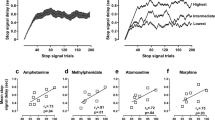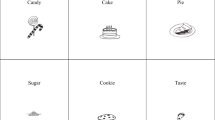Summary
Meprobamate and d-amphetamine vary in their behavioral effects as a function of the experimental milieu provided.
Numerous studies indicate that neither CNS depressant, stimulant, nor equivalent terms are sufficient in themselves to describe these drugs. li]2.|To investigate further the effects of both drugs on subject performance in the presence of neutral and disruptive stimuli, 91 male college students were shown, and asked to classify as quickly as possible, lists of frequently occurring nontaboo words and unambiguously taboo words, all of the same length, and all classifiable under animal, vegetable, or mineral categories. Subjects were never told that they would be shown taboo words.
Nineteen subjects received no medication, 24 received 1600 mg meprobamate, 24 received 20 mg d-amphetamine, and 24 received 1600 mg placebo. All medication was administered orally and in one dose. Double-blind procedures were used when necessary. li]3.|Major findings include: a) the meprobamate group did not differ significantly from the placebo group in its reaction time to any word category, but did respond more slowly to nontaboo words which followed taboo words than to those which came before presentation of the first taboo word. b) The d-amphetamine group also did not differ significantly from the placebo group in its reaction time to nontaboo words but did respond more slowly to taboo words. The reaction-time difference between taboo and nontaboo words was also greater in the d-am-phetamine group. c) Neither the meprobamate nor the d-amphetamine group differed from the placebo group in percentage of incorrect responses to any word category. d) The reaction time to nontaboo words of no group in the main study was significantly altered from the prto the posttest trials. And e) all groups responded more slowly to, and made a higher percentage of incorrect responses to, taboo words than to nontaboo words, indicating the efficacy of this sort of stimulus as a useful disrupter of performance. li]4.|These findings are discussed in the light of previous findings, and a possible similarity in the behavioral action of these two drugs is postulated.
Similar content being viewed by others
References
Adler, H. F.: Effects of various drugs on psychomotor performance at ground level and simulated altitudes of 18,000 feet in a low pressure chamber. J. Aviat. Med. 21, 221–236 (1950).
Aronfreed, J. M., S. A. Messick and J. C. Diggory: Re-examining emotionality and perceptual defense. J. Personality 21, 517–528 (1953).
Bitterman, M. E., and C. W. Kniffin: Manifest anxiety and “perceptual defense”. J. abnorm. soc. Psychol. 48, 248–252 (1953).
Brady, J. V.: Comparative psychopharmacology: animal experimental studies on the effects of drugs on behavior. In J. O. Cole and R. W. Gerard (Eds.), Psychopharmacology, Problems in Evaluation. Washington: National Academy of Sciences—National Research Council, 1958, Publ. No 583, pp. 46–63.
Dews, P. B.: Analysis of effects of psychopharmacological agents in behavioral terms. Fed. Proc. 17, 1024–1030 (1958).
Eriksen, C. W.: Perceptual defense as a function of unacceptable needs. J. abnorm. soc. Psychol. 46, 557–564 (1951).
Evarts, E. V.: A discussion of the relevance of effects of drugs on animal behavior to the possible effects of drugs on psychopathological processes in man. In J. O. Cole and R. W. Gerard (Eds.), Psychopharmacology, Problems in Evaluation. Washington: National Academy of Sciences—National Research Council, 1958, Publ. No 583, pp. 284–301.
Eysenck, H. J., S. Casey and D. S. Trouton: Drugs and personality — II. The effect of stimulant and depressant drugs on continuous work. J. ment. Sci. 103, 645–649 (1957).
Freeman, J. T.: Set or perceptual defense? J. exp. Psychol. 48, 283–288 (1954).
Geller, I., and J. Seifter: A conflict procedure for evaluation of drugs. Fed. Proc. 19(1), 28 (1960).
Goldstein, A., B. W. Searle and R. T. Schimke: Effects of secobarbital and d-amphetamine on psychomotor performance. J. Pharmacol. exp. Ther. 130, 55–58 (1960).
Hauty, G. T.: Methods for the mitigation of work decrement. USAF Sch. of Avia. Med. Report No 4, Proj. No 21-1600-004, Randolph Field, Tex., 1953.
, and R. B. Payne: Mitigation of work decrement. J. exp. Psychol. 49, 60–67 (1955).
, and R. B. Payne: Effects of d-amphetamine upon judgement. J. Pharmacol. exp. Ther. 120, 33–51 (1957).
Hochberg, J. E., S. L. Hober and T. A. Ryan: “Perceptual defense” as an interference phenomenon. Percept. mot. Skills 5, 15–17 (1955).
Holliday, A. R., and J. M. Dille: The effects of meprobamate, chloropromazine, pentobarbital, and placebo on a behavioral task performed under stress conditions. J. comp. physiol. Psychol. 51, 811–815 (1958).
Kornetsky, C.: Effects of meprobamate, phenobarbital, and d-amphetamine on reaction time and learning in man. J. Pharmacol. exp. Ther. 123, 216–219 (1958).
, A. F. Mirsky, E. K. Kessler and J. E. Dorff: The effects of d-amphetamine on behavioral deficits produced by sleep loss in humans. J. Pharmacol. exp. Ther. 127, 46–50 (1959).
Lacy, O. W., N. Lewinger and J. F. Adamson: Foreknowledge as a factor affecting perceptual defense and alertness. J. exp. Psychol. 45, 169–174 (1953).
Lindquist, E. F.: Design and analysis of experiments in psychology and education. Boston: Houghton Mifflin 1953.
Loomis, T.A., and T. C. West: Comparative sedative effects of a barbiturate and some tranquilizer drugs on normal subjects. J. Pharmacol. exp. Ther. 122, 532–535 (1958).
McGinnies, E.: Emotionality and perceptual defense. Psychol. Rev. 56, 244–251 (1949).
Peterson, E., and R. Chambers: The effects of meprobamate on oral reading performance. Paper read at Midwest. Psychol. Ass., Chicago, May, 1959.
Postman, L., W. C. Bronson and G. L. Gropper: Is there a mechanism of perceptual defense? J. abnorm. soc. Psychol. 48, 215–224 (1953).
Smith, G. M.: A simplified guide to statistics for psychology and education. New York: Rinehart & Co. 1953.
Thorndike, E. L., and I. Lorge: The teacher's word book of 30,000 words. New York: Columbia Univ. Press 1944.
Uhr, L., and J. G. Miller (Eds.): Drugs and behavior. New York: John Wiley & Sons, Inc. 1960.
Author information
Authors and Affiliations
Additional information
The establishment of the Laboratory in 1958 and its work since that time were made possible by generous grants from the Wallace Laboratories of Cranbury, New Jersey. The authors desire to express their especial appreciation to Dr. Frank M. Berger for his interest in and support of the work of the Laboratory.
This investigation was supported in part by a fellowship, MF-11,815, from the National Institutes of Health, Public Health Service.
Rights and permissions
About this article
Cite this article
Peterson, E.A., Haun, K. & Upton, M. The effects of meprobamate, d-amphetamine, and placebo on disjunctive reaction time to taboo and nontaboo words. Psychopharmacologia 3, 173–187 (1962). https://doi.org/10.1007/BF00412103
Received:
Issue Date:
DOI: https://doi.org/10.1007/BF00412103




